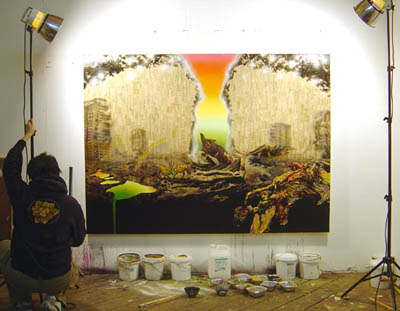 Gordon Cheung: Studio shot with "Wreck of Hope", 2006 (March 2006) Financial Times, ink, oil, acrylic gel and spray on canvas, 152.5 x 214 cm, 60 x 84 inches Broken Romanticism Gordon Cheung, Daniel Gustav Cramer, Simon Keenleyside, Peter Lamb, Caroline List, Miranda Lopatkin, Robin Mason, Hiraki Sawa, Gabriela Schutz, Stephen Walter In a time where our relationship with the natural land is ever decreasing, references to Romanticism is changing in accordance with present codes, practices and influences found in heavily urbanised environments. This exhibition shows work by ten artists that to varying extents deal with ideas of contemporary Romanticism through presenting visions of the future and reflecting upon a nostalgic and natural past. The difficulty with representing classically beautiful landscapes, memory and the yearning for "Homelands" at present clash with the disenfranchisement of a lost wilderness into domesticated, suburban, plastic and supermarket-ridden environments. The limitations of a physical Romanticism must find new routes in the face of a landscape ever increasingly shaped by convenience. Collaged columns from the Financial Times form the substrate for Gordon Cheungs' technoscapes. Littered with tower blocks, neon trees and graffiti of a cartoon cyber world they reveal the fractures in the glossy surfaces of modern life so that we might slip beyond to the emergent patterns and underbelly of what shapes our techno-sublime world. The heavily Romantic photographs of Daniel Gustav Cramer, often taken in low light using long exposures appear to be from deep inside the heart of forests and from the bottom of the seas. Worshiping the mysteries of the "Wald", and visions of places far into the Natural Realm they evoke fairytales of wonder and new beginnings. Simon Keenleyside explores the notion of the painting as a means of escape from the everyday and a place to safely reflect and marvel. Presenting a transformed and fantastic landscape originating from a familiar British setting. In Essex; forests, BMX tracks from his youth, marshlands and Leigh Creek, a favourite seaside haunt as a child fuel these enchanted suburban scenes. Peter Lamb constructs his multi media paintings and sculpture with both a sense of humour and a tinge of horror and destruction. The remnants of a past "Britton" - with its rigid class structures, social injustice, fox hunting and stuffed animals are chaotically re-pasted and the table is turned. They are tangible physical reminders of the past, a past that can be revaluated, misinterpreted, altered, distorted and even denied. Caroline List's journeys into the sublime merge photography and painting together to imbue her surfaces with an uncanny mist that harks back to memories of place and time. The photographic information and the marks applied seem to hover in a space in front of and beyond the canvas, accentuating the sense of impermanence. Known for her layered photographs and projections, Miranda Lopatkin's highly charged work deals with nostalgia and the placing of memory onto places, landscapes and histories. The overlapping of old and new family photographs onto interior spaces, highlight the passing down of traditions and learning through changing times, and coincide with recording snippets of anachronisms and nostalgic gestures in suburban environments. Using transcription as a method of reflection Robin Mason explores the socio-political, cultural and religious subject matter of pagan/Celtic mythology, pre reformation symbolism and the use of this heritage in contemporary practice. Combining threads from different eras the viewer is invited to wander and wonder at his reveries and obsessions. The coast, beaches and landscape of South Wales merge with the mountains and forests of the Vosges and the Black Forest in Germany. In Hiraki Sawa's video work - "Artificial landscapes, unexpected worlds, domestic and imaginary spaces interwoven, presences both felt and remembered... My present preoccupation is with those things that can be seen in the corners, on the edges, in between and beyond and somewhere else". Animations of faraway places enter the confines of his home to create places that are perhaps as much made as they are visited. Gabriela Schutz presents here an orchard vista. The "mathematical" and "scientific" modules present visions of globalisation and mass production. While the aesthetic language is based on technology mistakes and interruptions, there is a romantic and nostalgic air. They evoke the contemplation similar to looking at the sea. One can enjoy and get lost in them - until in coming back to reality, you are faced with an environmental cul-de-sac. Stephen Walter creates landscapes where objects are slowly taken over by their symbolic representations. Leaving us with forests of geographical map symbols and places where every inch is mapped and quantified for human purpose. The "awe", so revered by Walter, is presented by the sheer volume of symbols, paired down and separated from their real state. Tackling the notions of our increasing distance from the Land and the outlook of a deeply troubling long-term future, Walter decides to use mundane elements of contemporary and municipal culture to hark back to a sublime space. Exhibition: 10 March - 8 April 2006 Gallery hours: Wed-Sat 12am - 6pm Standpoint Gallery 45 Coronet Street Hoxton UK-London N1 6HD Email standpointeducation@btconnect.com www.standpointlondon.co.uk |